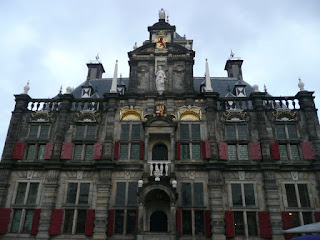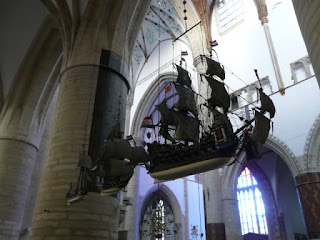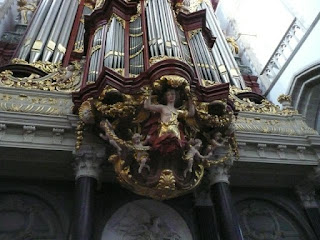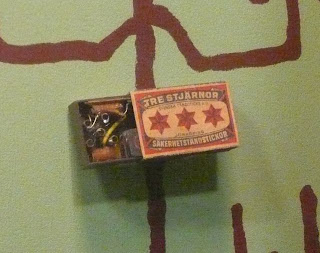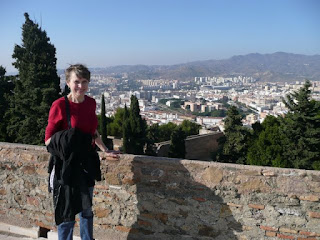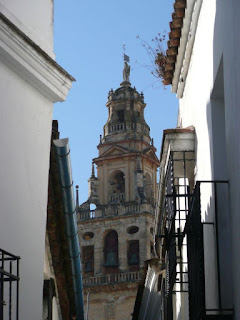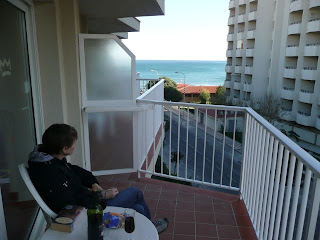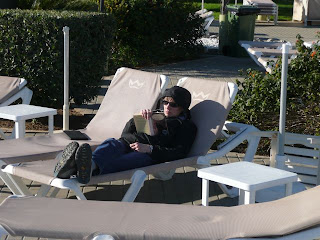If today is Tuesday, this must be Ronda. The bus arrived at our hotel before the sun. Our chain smoking tour guide did not appear to be Spanish, but it can be hard to tell -- far from the American stereotype, Spaniards come in every description, including blue-eyed blonds (the Vikings did get around!).
We have later discovered, however, that many guides here are actually Dutch, due to their capacity for languages. Because of their location in Europe, the numerous times their country has been invaded, and because Dutch TV refuses to dub the sound tracks of foreign programs, many Dutch people speak five or six languages. This is good, because almost all of the day tours are conducted in English, German, French and/or Spanish. The guide usually provides all information at least two or three times in different languages.
 |
| El matador awaits el toro? |
Ronda is a small city inland, in the mountains of Málaga province, about 800 meters above the sea. Aside from just being very scenic, it is considered the home of modern bullfighting. We actually got to stand in the ring, as well as see the pens where the bulls await their fate. The bullfighting museum even includes a Picasso painting of a matador – Pablo was a big fan here.
 |
| Picaso's Matador |
Ronda was also one of the last cities to be re-conquered by the Christians at the end of the Muslim period in Spain. Not surprising, as it sits on a rock outcropping with near vertical, 300 meter cliffs on three sides! The Medieval walls and Muslim-style gates are still in good shape. Great views, beautiful parks, and an interesting 17th century bridge linking the old town to the newer part of the city that bustled with shops and shoppers.
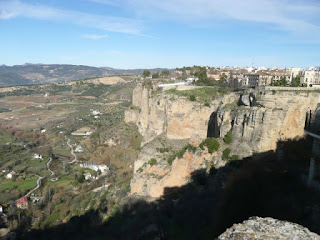 |
| Almost 1000 feet straight down, Ronda was very defensible! |
We also visited the “mother house” of the Don Bosco Fathers, who have Don Bosco schools all over the world (including in Gilbertville, Iowa). It was the home of a wealthy Ronda family until being donated, and the house and gardens are largely as they were as a family home a hundred years ago.
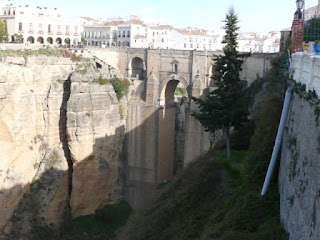 |
| 18th century bridge connecting the old city to the modern one. |
On the way back, we stopped briefly at the seaside town of Marbella, where the beautiful people hang out. The Saudi royal family has a huge palace here, as well as a private mosque, and a yaght in the marina that looks like a small ocean liner. Actor Antonio Banderas (a Málaga native) also has a home here. The shops were a bit out of our price range.
 |
| Minaret converted to the bell tower at Sevilla cathedral |
Wednesday’s trip was to Sevilla (Seville to Americans, but the Spanish call it “say-VEE-ya”), which is the next province over and a fairly long day trip. It’s a big modern city, the fourth largest in Spain, but the Medieval town (“El Centro”) at its core remains along the banks of the Rio Guadalquivir, which made it an important inland port city from Roman times.
 |
| Who is buried in Columbus' tomb? Sevilla claims he's really here. |
A grand cathedral is the heart of it. The reconquering Christian kings demolished a mosque and built their cathedral on the same spot, retaining the patio, or plaza, of the mosque where an English cathedral would have a cloister, and turning the minaret into a bell tower. The interior is extremely ornate, with tons of silver and gold, because Sevilla was the primary port for galleons coming back from the New World. One of the most ornate features is the tomb of Christopher Columbus.
 |
| Al Cazar Palace -- the exterior is the least impressive part. |
We also visited the Al Cazar, or palace, built by King Pedro I in the 1300s. Despite the fact that Seville had become Christian nearly 100 years previously, Pedro hired primarily Muslim artisans to rebuild this old fort into a grand show palace in the old mudejar style. It does look like something out of Arabian Nights, but the workers also secretly worked Koranic verses into the plaster and stone work, declaring things about Mohamed and Allah of which Pedro’s bishops would not have approved, had they deciphered it.
 |
| Una cerveza frio by the river near where Columbus sailed off to find India. |
We finished the day enjoying warm sunshine and
una cerveza frio (a cold beer) along the river bank, near the Tower of Gold lighthouse, next to the spot where Columbus sailed off to find a new world.

